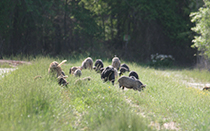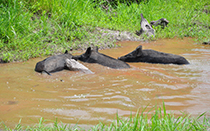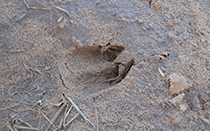Information about Wild Pigs
The History of Wild Pigs in the United States
 Wild pigs were first introduced to the
American landscape by Spanish explorers in the early 16th century. Explorers
landed first in Florida and released domestic stock as a quick food source for
when they returned to the area. Because of their unmatched survival ability pig
populations quickly expanded. Later
European settlers would practice free range farming, allowing pigs and other livestock to roam the landscape freely and unfenced. Unclaimed pigs further
contributed to the feral population. Another contributing factor to the feral
hog population was the Great Depression. During this time domestic stock were
released by farmers migrating to cities in search of work. Today wild pigs can
be found in 45 states in the US.
Wild pigs were first introduced to the
American landscape by Spanish explorers in the early 16th century. Explorers
landed first in Florida and released domestic stock as a quick food source for
when they returned to the area. Because of their unmatched survival ability pig
populations quickly expanded. Later
European settlers would practice free range farming, allowing pigs and other livestock to roam the landscape freely and unfenced. Unclaimed pigs further
contributed to the feral population. Another contributing factor to the feral
hog population was the Great Depression. During this time domestic stock were
released by farmers migrating to cities in search of work. Today wild pigs can
be found in 45 states in the US.
Biology and Behavior of Wild Pigs

Wild pigs have a high reproductive potential, often producing two litters per year. In addition, these animals are habitat generalist, which makes them highly successful allowing them to survive in almost any habitat. Pigs have a varied diet, eating almost anything—including carrion. Finally, the lack of natural predators throughout most of their range yields a low mortality rate among feral hogs, further promoting the spread of the species. Wild pigs form groups called sounders consisting of adult females and their young. These groups provide protection from predation.
Wild pigs possess the biological characteristics to adapt to nearly any habitat. Their high reproductive output allows them to quickly populate any area they invade.
Wild Pigs Inhabit Nearly Any Habitat
These animals are highly adaptable and have been found in mountainous areas, forests, salt and brackish swamps and marshes, old growth pine forests, semi-arid brush habitats, tropical rain-forests, and more.
Reproduction
A major contributing factor for feral hog success is a short reproductive cycle and high litter sizes. These animals are the most fertile large mammal in existence with a gestation period between 112 and 115 days, or about 16 weeks. A typical sow will give birth to two litters per year consisting of 4 to 6 piglets per litter. Under the right conditions a sow may produce up to 13 piglets at one time. This is due to their domestic history. Coming from domestic stock these animals have been bred to produce as many offspring as possible for the purpose of pork production.
Diet
Wild pigs are opportunistic omnivores. This means they will consume almost anything from mast crops and agriculture crops to grub worms and carrion. Although wild pigs are not predators, they will consume deer fawns, eggs of ground nesting birds, livestock, and many other food items.
Low Mortality in the Pig Population
The mortality rate in the feral hog population is low. This is due to few natural predators and their social structure, but where they occur, black bears, mountain lions, and alligators will prey on wild pigs. Wild pigs are most vulnerable to predation when they are young—40 lbs and less—but these familial groups provide protection for the young and reduce the number of individuals taken by predators. The majority of the mortality within the feral hog population comes from human activities such as hunting, trapping, or vehicle collision. Mortality rates related to disease and parasites are unknown in wild pigs populations but are suspected to be high.
What Does a Wild Pig Look Like?
 Since wild pigs are nothing more than
domestic hogs that have reverted to a wild state they look very similar to
domestic pigs seen on pig farms across the country. Members
of the Suidae genus have a coarse and sparse hair coat that varies in color.
Pigs are often seen in black, red, red and white, black and white, or red and
black. Pigs have a paraxonic foot with only the forward pairs of toes (the
third and fourth) bearing weight. The length and weight that wild pigs can
reach depends upon the breed of domestic stock they derived from and the
degree of hybridization with wild boar. Ultimately, the size of a wild pig depends food availability. Males on average weigh 220 pounds
while females average about 155 pounds; however, if they have available
resources larger sizes can be reached.
Since wild pigs are nothing more than
domestic hogs that have reverted to a wild state they look very similar to
domestic pigs seen on pig farms across the country. Members
of the Suidae genus have a coarse and sparse hair coat that varies in color.
Pigs are often seen in black, red, red and white, black and white, or red and
black. Pigs have a paraxonic foot with only the forward pairs of toes (the
third and fourth) bearing weight. The length and weight that wild pigs can
reach depends upon the breed of domestic stock they derived from and the
degree of hybridization with wild boar. Ultimately, the size of a wild pig depends food availability. Males on average weigh 220 pounds
while females average about 155 pounds; however, if they have available
resources larger sizes can be reached.
Wild Pig Sign
 If wild pigs are present in a given
area the sign will be obvious. Their feeding behavior
upturns soil promoting erosion and causing damage to crops,
fields, tree roots, and food plots. Wild pigs create wallows where they
roll around in mud in order to keep cool and slough off external parasites.
If wild pigs are present in a given
area the sign will be obvious. Their feeding behavior
upturns soil promoting erosion and causing damage to crops,
fields, tree roots, and food plots. Wild pigs create wallows where they
roll around in mud in order to keep cool and slough off external parasites.
Often landowners and farmers do not realize they have hogs until they actually see them or the damage caused by these animals has become extensive. Therefore it is important for landowners and farmers to familiarize themselves with hog sign so they can take action before the pigs become a problem. Feral hog sign includes:
- Tracks
- Nesting/bedding sites: these are areas under limbs, vines, or in dense grassy locations that provide cover from predators and from wind and weather. Bedding areas can be identified by overlaid grass or clearings in the understory that has not been heavily rooted.
- Rooting: over turned soil that looks as if it has been plowed with a piece of farm equipment. This is a result of hog feeding behavior and causes extensive damage.
- Wallows: often found in wet locations, wallows are impressions in the ground where hogs roll their bodies in mud as a means of keeping cool.
- Tree/post rubs: seen on trees around 12-30 inches off the ground where hogs scrape off the mud from wallowing.
- Tree tusking: this creates scars or complete bark removal at the base of trees, around 18-24 inches off the ground. This is a form of scent marking for males.


